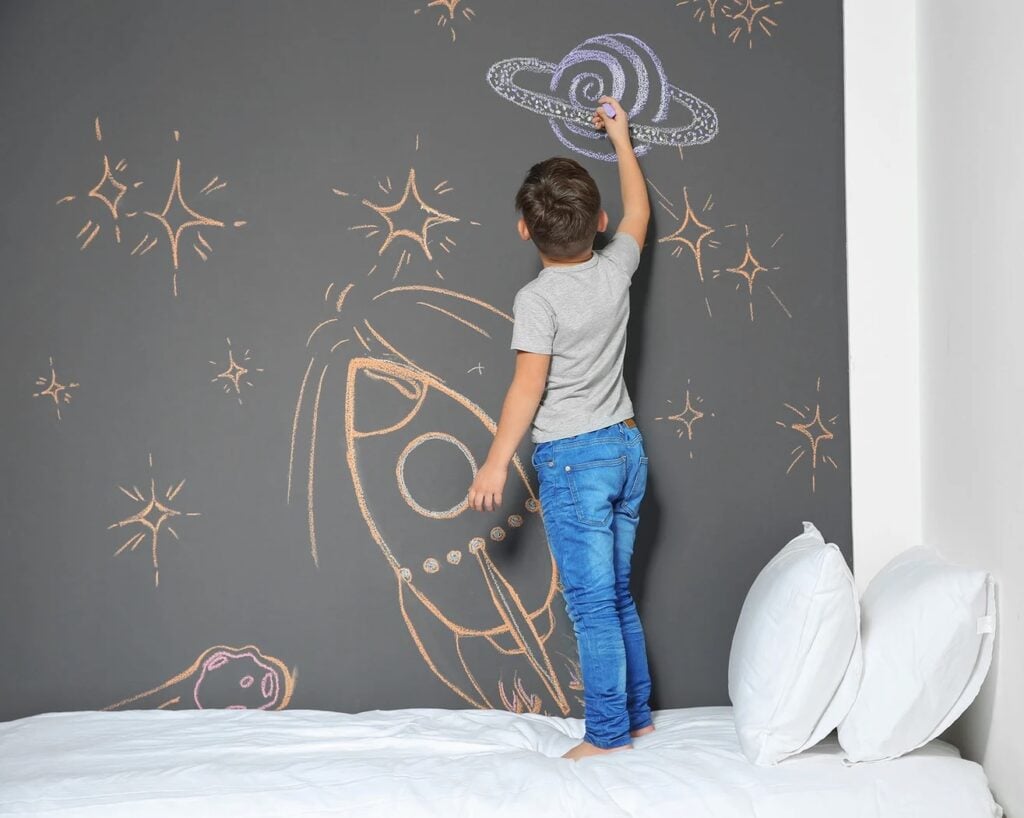Vertical Play for Kids: Strengthen Motor Skills, Coordination & Focus
Ever notice how kids love drawing on walls? Turns out, they’re onto something. Working on a vertical surface isn’t just fun, it’s one of the most powerful (and underused) ways to support your child’s motor development, sensory needs, and even handwriting skills.

Having a vertical surface for your child to work on can offer numerous benefits and plenty of fun. Working vertically can be set up in advance or incorporated into spontaneous activities to help strengthen your child’s fine motor development, strength, and stability.
The Importance of Vertical Work
Working on a vertical surface, such as a wall, easel, chalkboard, or magnetic board, can help kids build strength in their hands, elbows, and shoulders and promote correct wrist placement for pencil grasp.
Due to the rise in technology use, kids’ lives today look very different than ours did. Paired with less space outdoors and fewer opportunities to roam and climb trees, modern childhood and parenting look very different from how many of us grew up.
There is evidence that shows that children who spend time in nature become happier adults. From a developmental perspective, children who spend time in nature tend to engage in activities that support their growth and development. Climbing trees, swinging, picking up sticks, drawing letters in the sand, digging, playing in the mud… the list goes on!
My teenagers endearingly call their little sister and her friends “iPad kids.” The entire grade school generation is getting called out for their excessive technology use by…. teenagers? The very same teenagers, the kids older than them, called “screenagers”? Yep. You heard it right. Grade schoolers are on their tablets so much that even teenagers notice!
At school, kids type more than they write with pencil and paper, and the days of writing on chalkboards seem to be over. If kids are missing these developmental tasks, what does that mean for their motor development?
If developmental motor skill milestones are missed and no effort is made to ensure the brain and muscles develop properly, it can lead to issues with core strength, hand-eye coordination, posture, walking, and even driving.
Incorporating motor tasks, such as working on vertical surfaces, can be a huge support to a child’s development — especially during the early years. Vertical play is beneficial for toddlers through elementary-aged children, and even tweens can benefit from certain activities involving standing and full-body movement.
The Benefits of Vertical Surface Work
Providing your children with the opportunity to work vertically can have significant benefits for their developmental growth. It’s imperative to build these strengths when you can at home, since they are busy with other types of growth at school.
Strength and Flexibility
Working on a vertical surface helps build strength and stability in children’s hands, wrists, elbows, and shoulders. It provides an opportunity for bigger arm movements, and kids work against gravity to make vertical, horizontal, and diagonal lines. Whether they stand or kneel, they are building core strength.
Bilateral Coordination and Crossing Midline
Tracing or stabilizing a paper to write on a vertical surface requires the use of both hands, which is a great way for kiddos to develop bilateral coordination.
Additionally, large surfaces provide ample space for kids to use, which encourages midline crossing. This act can help regulate the nervous system. As they reach to fill the space, crossing the midline becomes a natural part of the activity.
Spatial Awareness and Sensory Needs
With a vertical surface, it is much clearer what is left, right, up, down, top, or bottom. These simplified directions help with spatial awareness, proprioception, the vestibular system, and sensory input.
Children who need to fidget often focus better when working standing up, and they receive sensory feedback from various surfaces, such as chalk on a chalkboard or a marker on a whiteboard. Since it involves the whole body, it helps with both spatial awareness and sensory needs.
The strength and pressure it takes to write vertically is also good sensory input!
Pencil Grip and Hand-Eye Coordination
With the increased use of technology, children’s hand muscles are developing differently than they did in the past. Writing or coloring on a vertical surface promotes a better wrist position and encourages hand stabilization, leading to a more effective pencil grasp.
Vertical work is closer to eye level, which is better for hand-eye coordination. Working vertically helps improve hand-eye coordination and strengthens hand muscles, getting kids back on track with proper strength, coordination, and development.
Easy Vertical Surface Activities for Kids
Incorporating vertical surface work doesn’t have to be complicated. It can fit right into your regular daily tasks and routines. It won’t feel like work—instead, it will be fun and engaging for your kiddo.
The best way to make vertical work seamless is to prepare the environment so it’s a no-brainer once your child chooses an activity.
Walls
It’s always easy to tape large paper to the wall and let your child color on it. To make it super simple, use a paper roll mount. Tracing objects or stencils is fun and easy with this setup.
Peel-and-stick chalkboards and marker boards are both great vertical surfaces that make it easy to have the space prepared for success. A Momsboard would come in super handy for a wide variety of vertical activities, too.
Easel
If you’re short on wall space, an easel is a perfect way to save space since it can fold up and be tucked away when not in use. Some easels have chalkboards, whiteboards, and paper rolls for easy transition between activities.
Stock up on sticker charts or sticker art, paint and paintbrushes, dry-erase markers, crayons, and other art supplies, and your child will be busy for hours.
Windows
Use a sliding glass door or an eye-level window to make vertical surface work fun without taking up any extra floor or wall space. Window stickers, window clings, or window chalk markers are all perfect to have on hand and easy to clean up.
If you’re adventurous, big windows are perfect for finger painting or shaving cream! It provides kids with a bit of extra sensory input and is easy to clean up. Also, did you know you can use slime on windows?
Technology
The truth is that technology is a huge part of our kids’ lives, and it’s here to stay. With it comes innovations that can truly help the world. However, that doesn’t mean we should let it hinder proper development.
Prop up tablets when your children use them, and consider apps that help them develop hand-eye coordination, such as tracing or coloring. Using a stylus can also help with pencil grasp.
Vertical Activities
If you’re looking for some specific activities for vertical work, your kids are sure to engage in a few of these.
- Create an outdoor writing center on a warm day.
- This self-portrait mirror drawing activity is not only developmentally appropriate, it turns out super cute.
- This star hunt game is perfect for preschoolers and is super easy to set up and reuse.
- Readers can make a magnetic storyboard on a wall magnet or a refrigerator. My teens love these!
- Let them finger paint or use window chalk on glass doors.
- Roll out a large sheet of butcher paper for vertical coloring or letter tracing.
- Hang clipboards with activity sheets or coloring pages at standing height for easy access.
Supporting your child’s development doesn’t require fancy tools or rigid schedules. Vertical surface play is a simple, screen-free way to help your child build strength, coordination, and confidence – all while having fun.
Set up a few accessible stations around your home, and let your child explore, create, and grow.

